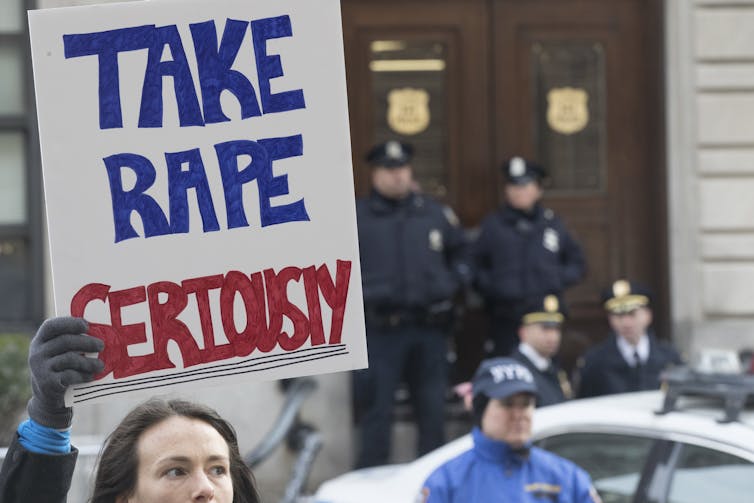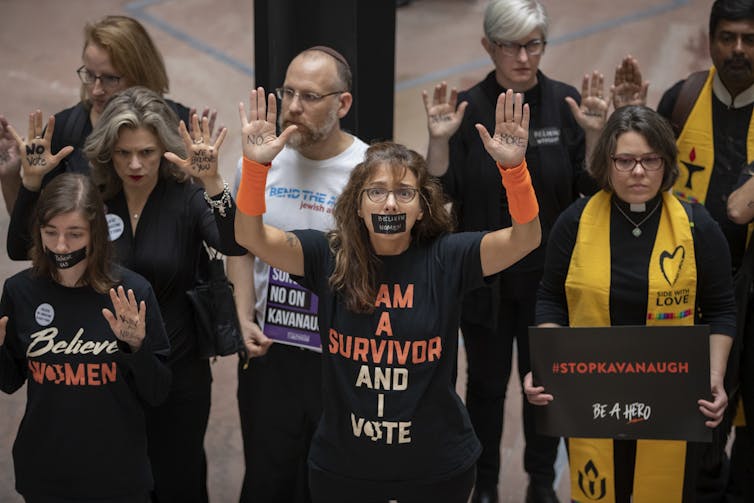Sen. Martha McSally, pioneering Air Force pilot, shows how stereotypes victimize sexual assault survivors again
- Written by Leigh Goodmark, Professor of Law, University of Maryland, Baltimore
Martha McSally was the first woman[1] to fly combat missions for the United States Air Force after the prohibition on female combat pilots was lifted in 1991. She later sued the United States Department of Defense[2], challenging a policy that required servicewomen in Saudi Arabia to wear abaya (full-body coverings) when traveling off-base. In 2014, she was elected to the House of Representatives[3] and is a currently a United States senator from Arizona.
Martha McSally is a powerful woman.
But when a superior Air Force officer raped her, “I was ashamed and confused. I thought I was strong but felt powerless,” McSally said[4]. She blamed herself. And she chose not to report the assault.
The feelings McSally describes are common among victims of sexual violence[5]. McSally is not alone in her decision not to report her victimization. In 2016, only about 23 percent of rapes were reported[6] to law enforcement.
In my 25 years of representing survivors of gender-based violence[7] as an attorney, I have met hundreds of women like McSally. The shame and powerlessness that these women feel are a direct result of antiquated notions about rape and sexual assault that were, until recently, embedded in the legal system.
Those ideas continue to affect how police, prosecutors and judges see victims of violence and how victims see themselves.
 An activist demonstrates after a Brooklyn, N.Y., police captain made a distinction between acquaintance rapes and ‘total-abomination rapes where strangers are being dragged off the streets.’
AP/Mary Altaffer[8]
An activist demonstrates after a Brooklyn, N.Y., police captain made a distinction between acquaintance rapes and ‘total-abomination rapes where strangers are being dragged off the streets.’
AP/Mary Altaffer[8]
Institutional skepticism
Reforming the law[9] was a priority for the anti-rape movement of the 1970s and 80s.
The rape law of the time both implicitly and explicitly challenged the credibility of complainants. Many states gave jurors a cautionary jury instruction derived from 17th-century English jurist Sir Matthew Hale’s observation[10] that rape “is an accusation easily to be made and hard to be proved.”
Prior to the rape law reform of the 1970s and 80s, the law in most states required rapes to be promptly reported. The failure to make a prompt report suggested that the event was fabricated.
Rape law in many jurisdictions precluded prosecution without corroboration of the victim’s testimony; a rape victim, on her own, could not be a credible witness. Many state laws also required that rape victims fight back against their attackers – resisting “to the utmost,”[11] according to the law.
And defendants could introduce evidence about the accuser’s sexual history to undermine[12] the claim that the sex was not consensual.
These laws have, for the most part, been repealed. But the skepticism of rape claims and rape victims underlying these laws continues to shape how the legal system responds to rape and sexual assault.
 Protesters demonstrate as the Senate Judiciary Committee hears from Supreme Court nominee Brett Kavanaugh and Christine Blasey Ford, Sept. 27, 2018.
AP/J. Scott Applewhite[13]
Protesters demonstrate as the Senate Judiciary Committee hears from Supreme Court nominee Brett Kavanaugh and Christine Blasey Ford, Sept. 27, 2018.
AP/J. Scott Applewhite[13]
Victim credibility
Official reports detail just how poorly many police departments and prosecutors understand and deal with rape.
A 2011 United States Department of Justice report describes how police in New Orleans[14], for example, asked a victim of sexual assault “if she screamed or resisted the perpetrator.” When she said she had not, the detective asked why not, and commented that “the victim ‘seemed very calm and unrattled.’” The implication, of course, is that a true victim would scream and fight; a calm and unrattled victim is not a credible victim.
In a 2016 report, a U.S. Department of Justice investigation of the Baltimore Police Department[15] documents detectives’ skepticism of victims who delayed reporting and detectives’ suggestions that victims had done something to trigger assaults. Police and prosecutors openly ridiculed victims who they did not believe.
In one exchange, a prosecutor wrote, “[T]his case is crazy. … I am not excited about charging it. This victim seems like a conniving little whore. (pardon my language)”; the officer responded, “Lmao! I feel the same.”
In a 2014 report, the Department of Justice described how Missoula, Montana[16] police told a woman that “because ‘no one had a limb cut off and there was no video of the incident,’ prosecutors ‘wouldn’t see [her rape] as anything more than a girl getting drunk at a party.’” Between January 2008 and May 2012, the Missoula County Attorney’s Office filed charges in less than 17 percent of the rape cases referred for prosecution. By contrast, in 2012-2013 about 48 percent of sexual assault related arrests[17] resulted in charges being brought in Arizona.
As recently as September 2018, many observers dismissed Dr. Christine Blasey Ford’s account[18] of being sexually assaulted by Supreme Court Justice Brett Kavanaugh because of her failure to promptly report.
Victim stereotypes
Society generally, and law enforcement specifically, still expects rape victims to look and act a certain way[19].
They should be demure, virginal and blameless; they should not have had previous sexual contact with their attackers; they should be openly emotional about their experiences; they should report promptly; they should fight to defend their honor[20].
When rape victims fail to conform to these stereotypes, law enforcement doubts their stories.
Without a “good” victim[21], law professor Tamara Rice Lave has argued, police are less likely to make arrests, prosecutors are less likely to bring cases to trial, and judges and juries are less likely to convict[22].
These stereotypes affect how victims respond to rape and sexual assault[23].
Women see that the system continues to blame them for being raped. Like Sen. McSally, they don’t report because they don’t believe that the system will work for them. When they do report, they often feel, as McSally described, “like the system was raping me all over again.”
Law enforcement reliance on rape stereotypes heightens the shame, powerlessness and revictimization that women who have been raped feel when they do report – and prevents other women from reporting in the first instance.
The Department of Justice reports cited above suggest that changing the law has not changed attitudes toward rape victims. Only by changing the wider culture will we achieve that goal.
At the University of Maryland Carey School of Law, where I teach, we’re trying to make that cultural change through the Erin Levitas Initiative for Sexual Assault Prevention[24].
As we describe our initiative[25], “Our goal is to change the way that boys and young men think about women by addressing the attitudes that drive violence.”
The Levitas Initiative will use restorative justice principles, which focus on repairing the harm experienced by victims, to respond to incidents of school-based sexual harassment and educate middle school students on sexual violence.
We hope that restorative dialogue and active accountability will undermine the attitudes and stereotypes that continue to haunt victims of rape – something the law has not been able to achieve.
References
- ^ Martha McSally was the first woman (aviationweek.com)
- ^ She later sued the United States Department of Defense (www.washingtonpost.com)
- ^ elected to the House of Representatives (ballotpedia.org)
- ^ McSally said (www.vox.com)
- ^ common among victims of sexual violence (www.psychologytoday.com)
- ^ about 23 percent of rapes were reported (www.bjs.gov)
- ^ 25 years of representing survivors of gender-based violence (www.law.umaryland.edu)
- ^ AP/Mary Altaffer (www.apimages.com)
- ^ Reforming the law (books.google.com)
- ^ Sir Matthew Hale’s observation (ir.lawnet.fordham.edu)
- ^ resisting “to the utmost,” (www.vox.com)
- ^ the accuser’s sexual history to undermine (journals.sagepub.com)
- ^ AP/J. Scott Applewhite (www.apimages.com)
- ^ New Orleans (www.justice.gov)
- ^ investigation of the Baltimore Police Department (www.justice.gov)
- ^ Missoula, Montana (www.justice.gov)
- ^ 48 percent of sexual assault related arrests (repository.asu.edu)
- ^ observers dismissed Dr. Christine Blasey Ford’s account (www.usatoday.com)
- ^ Society generally, and law enforcement specifically, still expects rape victims to look and act a certain way (www.salon.com)
- ^ they should report promptly; they should fight to defend their honor (scholarship.law.georgetown.edu)
- ^ Without a “good” victim (repository.law.miami.edu)
- ^ juries are less likely to convict (impact.ref.ac.uk)
- ^ how victims respond to rape and sexual assault (www.researchgate.net)
- ^ Erin Levitas Initiative for Sexual Assault Prevention (www.law.umaryland.edu)
- ^ our initiative (www.law.umaryland.edu)
Authors: Leigh Goodmark, Professor of Law, University of Maryland, Baltimore

